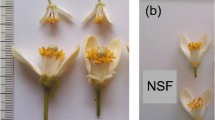Summary
The effect of self-pollination of cucumber (Cucumis sativus L.) for 6 generations in lines developed from the North Carolina Medium Base Pickle population was determined by regression of trait expression for each generation on Wright's coefficient of inbreeding. Two yield traits (total and marketable), earliness and 3 fruit quality traits (shape, color and seedcell size) were evaluated in 2 environments (spring and summer, 1983). The regression did not result in significant negative slopes, indicating that inbreeding depression was not important in the population for the traits studied. Midparent heterosis was found for most traits in many hybrids obtained from crossing S6 lines with the gynoecious inbred line, Gy 14A.
Similar content being viewed by others
References
Allard, R. W., 1960. Principles of plant breeding. John Wiley and Sons, Inc., New York, p. 38.
Ghaderi, A. & R. L., Lower, 1978. Heterosis and phenotypic stability of F1 hybrids in cucumber under controlled environment. J. Amer. Soc. Hort. Sci. 103: 275–278.
Ghaderi, A. & R. L., Lower, 1979. Heterosis and inbreeding depression for yield in populations derived from six crosses of cucumber. J. Amer. Soc. Hort. Sci. 104: 564–567.
Hayes, H. K. & D. F. Jones, 1916. First generation crosses in cucumbers. Conn. Agr. Exp. Sta. Ann. Rep. p. 319–322.
Hutchins, A. E., 1938. Some examples of heterosis in cucumber, Cucumis sativus L. Proc. Amer. Soc. Hort. Sci. 36: 660–664.
Jenkins, J. M., Jr., 1942. Natural self-pollination in cucumber. Proc. Amer. Soc. Hort. Sci. 40: 411–412.
Miller, C. H. & G. R., Hughes, 1969. Harvest indices for pickling cucumbers in once-over harvested systems. J. Amer. Soc. Hort. Sci. 94: 485–487.
Robinson, R. W., H. M., Munger, T. W., Whitaker & G. W., Bohn, 1976. Genes of the cucurbitaceae. HortScience 11: 554–568.
Scott, G. W., 1933. Inbreeding studies with Cucumis melo. Proc. Amer. Soc. Hort. Sci. 29: 485 (abstr.).
Sentz, J. C., H. F., Robinson & R. E., Comstock, 1954. Relation between heterozygosis and hybrid vigor in maize. Agron. J. 46: 514–520.
Shull, G. H., 1980. The composition of a field of maize. Amer. Breeders Assoc. Rep. 4: 296–301.
Smith, O. S., R. L., Lower & R. H., Moll, 1978. Estimates of heritability and variance components in pickling cucumber. J. Amer. Soc. Hort. Sci. 103: 222–225.
Wehner, T. C., 1984. Estimates of heritabilities and variance components for low-termperature germination ability in cucumber. J. Amer. Soc. Hort. Sci. 109: 664–667.
Wehner, T. C., T. J., Monaco & A. R., Bonnanno, 1984. Chemical defoliation of cucumber vines for simulation of once-over harvest in small-plot yield trials. HortScience 19: 671–673.
Author information
Authors and Affiliations
Rights and permissions
About this article
Cite this article
Rubino, D.B., Wehner, T.C. Effect of inbreeding on horticultural performance of lines developed from an open-pollinated pickling cucumber population. Euphytica 35, 459–464 (1986). https://doi.org/10.1007/BF00021854
Received:
Issue Date:
DOI: https://doi.org/10.1007/BF00021854




